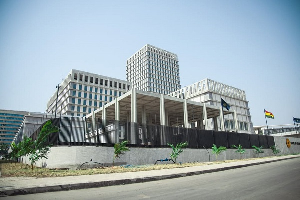Having practiced industrial safety & health and environment in Ghana and other countries for 11yrs and more, it has become obvious that the concept of monitoring and ensuring employee safety and health is gradually becoming acceptable in many sectors of our Ghanaian industries, especially mining and recently in the Oil and Gas industry.
Though the rest of the sectors such as the agro, construction, manufacturing and the remaining industries are struggling to implement aspects of this concept in their respective areas, there is generally, the awareness (most often with lack of understanding) of their practice. Seemingly an improvement over what was happening some 10 years ago, practicing Safety and Health in the Ghanaian industry has seen some continuous improvement, yet there’s much room for enhancement.
Most companies have focused on the tracking of injury and illness statistics, reporting the statistics and benchmarking them with some "strange standards" without properly aligning them to the risk profile of the company or not even understanding the risk profile of the said companies. The government ministries, departments and agencies are not exceptions to this trend.
Indeed, occupational accident and incident reporting has been the main focus for most companies’ and the nation's Safety & Health Environment programs, if they exist. The question is, what then must go into a SHE compliant, leadership commitment to SHE, proactive leadership in SHE, and of course people (employee) caring company's approach to managing occupational safety and health in Ghana, and even in most parts of the "western world"?
In many instances, many organizations report the figures, they set key performance indicators around number of injuries and illnesses and property damages, etc. which are mostly lagging indicators. Example, the Ghana Road Safety Commission will focus on reporting how many vehicle accidents have occurred per region within the year, how many fatalities we have had in the country, etc.
Most companies will also be looking at how many lost time injuries, medically treated injury, first aid injuries, occupational illness, and non occupational illnesses, and sometimes include figures for levels of property damages the company has encountered. It is surprising to know that most companies even set KPIs on how many people they should or should not kill within the year, and call it fatality rate. Companies go to a further extent to even track and trend what is called Lost Time Injury Frequency Rate (LTIFR) as well as Fatality Frequency Rate measuring the number of people they are prepared to be killing per month over the year and assess if they are exceeding their limit or not.
I must say this happens not only in Ghana, but also in the United States of America, Australia, United Kingdom, South Africa, and most parts of the world. Having had experience practicing this profession in many companies from most of these so-called western countries, I remain left with an unanswered question; if we are indeed practicing Occupational Safety and Health in the industry with the intention of preventing injuries and illnesses of our dear workers, why do we set our KPI's and pay bonuses on lagging indicators? Do companies actually understand the statistics for leading indicators as well? Again, what then do we need to focus on to ensure occupational injuries and illnesses as well as property damages are prevented in the industry?
By applying the same management controls and disciplines that we often apply to injury reporting, illness reporting and accident / incident reporting to additional related areas, the effectiveness of overall health & safety programs can be improved and risks better managed. These require measuring and improving the lead indicators, which tend to prevent the accidents from occurring.
Focus in these four areas:
- Hazard Identification, Risk Assessments and Controls
- Industrial / Occupational Health & Hygiene
- Corrective and Preventive Action Management
- Training & Capacity Building
Can lead to dramatic improvements in overall SHE performance and ensure that
organizational goals for operational excellence are met
3a. Hazard Identification, Risk Assessments and Controls
Would it not be prudent for companies to set KPI on how many hazards are identified by workers (especially the managers / supervisors) and how many of them are corrected before they lead to undesired events? Identifying these hazards is not always a formal process, it can be done by inspections, audits, just behavior based on walk downs/observations, interaction with workforce, and also formal assessment of task steps. This does not end there, after identifying these hazards, we need to identify effective and risk based controls for these hazards. Often times, most companies do not consider how likely the hazard can make an accident occur, and should it occur, how severe the consequence can be.
Understanding this concept aids establishment of a good risk profile for the company's operations, hence, appropriate controls considering most effective on the hierarchy of controls - Elimination through Engineering, Administrative before consideration Personal Protective Equipment. Why will a company not tie the bonus to how many hazards they identify and correct instead of how many accidents result from these identified / unidentified hazards?
3b. Industrial / Occupational Health & Hygiene
Talk about Industrial / Occupational Hygiene and a typical Ghanaian Engineer, Doctor, Lawyer, Manager Lecturer, Laborer, etc - irrespective of the level of education or profession - will tell you that it's about kitchen inspections and sanitary inspections, food handlers control and that's it. Even very few SHE professionals understand this concept, and hence, the failure. Again, the USA, UK, SA, Aussie, etc. are not exceptions.
The "Anticipation, recognition, evaluation and control of physical, chemical, biological and ergonomic stressors at work place" is what we call Industrial / Occupational Hygiene. In simple terms, understanding the job roles for the employees, their potential exposures at the work place, the existing controls to prevent such exposures at workplace, the potential / actual consequences (eg. health impacts) should the worker be exposed, and what medical programs are in place to monitor and detect the post exposure effects and treatment are what go into Industrial / Occupational Health & Hygiene.
Would companies not save a lot of workers from occupational illnesses if attention is given to this area? Why will the industry not tie the bonuses to how many of such exposures get prevented instead of how many occupational illnesses we record?
3c. Corrective and Preventive Action Management
Identification of appropriate and effective control for identified risk or hazard is very critical to preventing it from recurring or leading to an accident. As soon as an accident occurs anywhere in the company, there is only one thing certain. That is; there has been a control failure, which is due to inappropriateness or ineffectiveness or both. Would it not rather be appropriate to tie a company's KPIs to how many controls for identified hazards / near misses are closed out instead of reporting on how many accidents occur in a particular period?
3d. Training & Capacity Building
Competency of the workforce is in itself a major factor in preventing accidents in the industry. If an employee does not know the job that is supposed to be done, he will definitely not know how it is supposed to be done, hence know not what can go wrong while doing the job and obviously, not know what he/she can do to prevent the wrong from taking place and how to do that. In simple terms, employees' knowledge and competence is critical to prevention of accidents.
My experience shows me that, most companies in Ghana and other African countries recruit so called expatriates with for example, carpentry background, and put them in operational leadership roles. These people are supposed to coach and mentor the locals, but most often they end up learning on the job due to lack of knowledge and/or experience? Is this not a recipe for accident causation? Would it not be better to set a company's KPI to the number of persons developed to be competent in their roles, instead of the number of persons injured on job due to incompetence?
SHE management performance in a company has mostly been measured by using just the statistics of the lagging indicators which I consider as being a reactive approach. Most companies set their KPI's for performance and bonus payment useful to SHE management with lagging indicators in Ghana as well as many other countries including USA, UK, SA, etc. The nation itself has got no proactive approach to managing SHE in Ghana, and hence all the companies come in with their respective approaches and therefore, the lagging statistical trending itself is not only inappropriate and inefficient, but also all over the place.
a. Set lead indicators (proactive) as KPI's
b. Don't tie bonuses to lagging indicators
c. include in the job roles of everybody from CEO to the least laborer, appropriate SHE responsibilities and accountabilities
d. include the above 4 points in your focus areas, and ensure your corrective actions are indeed specific, measureable, achievable, realistic, time bounded, and continuously evaluated for improvement.
(MSc. Quality, Safety & Environment; BSc. Chemical Engineering; P.G.Cert Industrial Hygiene; Lead Auditor ISO 14001 & OHSAS 18001; Specialist-International Institute of Risk & Safety Management; Member-American Industrial Hygienists Association)
e-mail: jsannan5@yahoo.com














